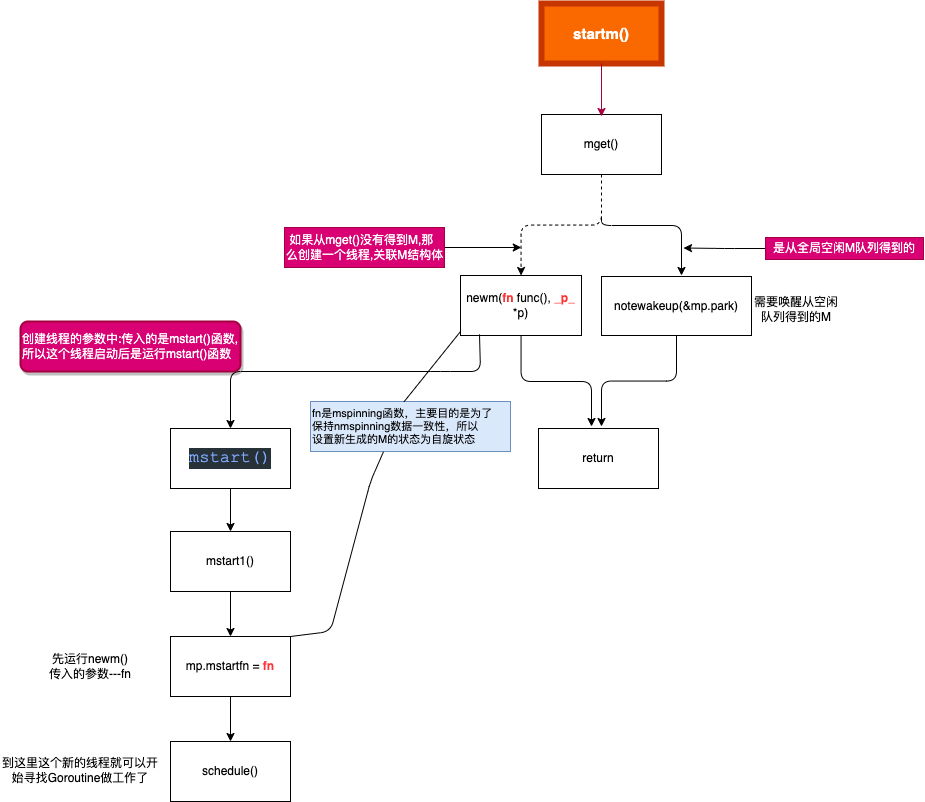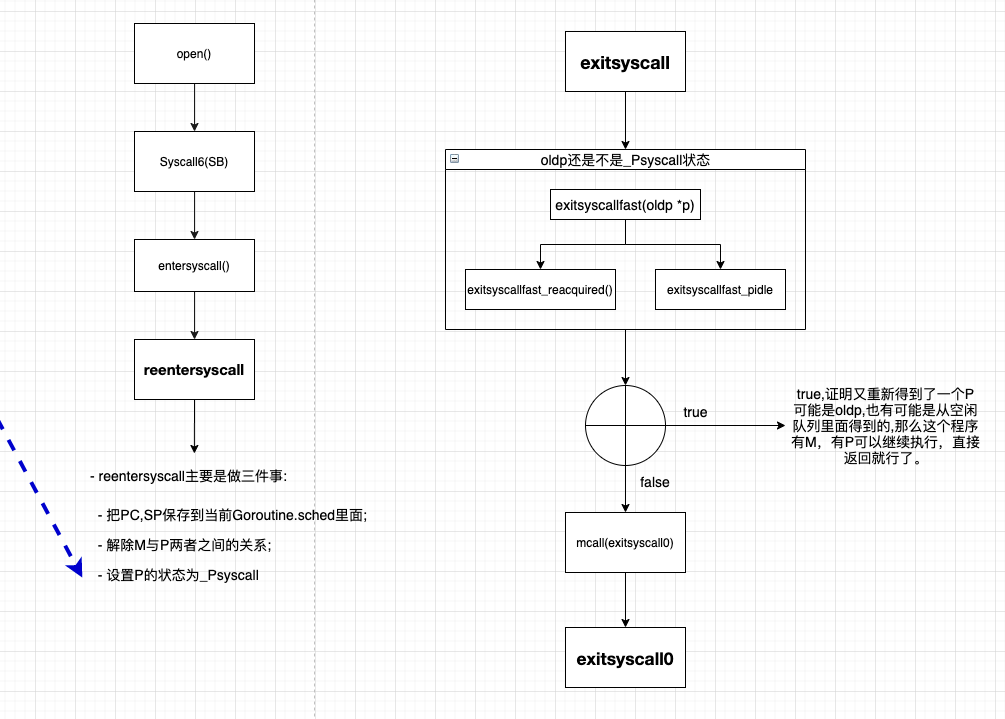执行系统调用抢占 #
handoffp #
handoffp函数:判断是否需要启动工作线程来接管_p_,如果不需要则把_p_放入P的全局空闲队列.
如果当前P的运行队列有任务/全局队列有任务,有gc任务,大概率整个系统有任务待做,或者当前P是最后一个P要用作轮询网络
其中大概率整个系统有任务待做: 由第24行
atomic.Load(&sched.nmspinning)+atomic.Load(&sched.npidle) == 0决定:如果没有P空闲,而且这些没空闲的P连接的M不是处在自旋状态(没有自旋的M),证明其他P都在工作(而不是假装工作实际是在伺机从其他队列偷任务那种),是不是说明整个系统除了当前P外都在做事,所以大概率某些P的运行队列上有任务积压,所以我们应该启动M,让它跟当前P连接,去别的P中偷任务)
| |
其中startm函数我们前面介绍过 startm :

系统调用收尾,如从系统调用返回,如何重新得到P #
定义程序 #
main.go
package main
import (
"fmt"
"os"
)
var path = "appss.txt"
func isError(err error) bool {
if err != nil {
fmt.Println(err.Error())
}
return (err != nil)
}
func main() {
var file, err = os.OpenFile(path, os.O_RDWR, 0644)
if isError(err) {
return
}
defer file.Close()
}
gdb调试前准备 #
编译程序 #
编译一下源代码: go build -gcflags "-N -l" -o test ..
准备mcall函数断点的文件 #
- gdb
list /usr/lib/golang/src/syscall/zsyscall_linux_amd64.go:62list /usr/lib/golang/src/syscall/asm_linux_amd64.s:44
gdb #
// func Syscall6(trap, a1, a2, a3, a4, a5, a6 uintptr) (r1, r2, err uintptr)
TEXT ·Syscall6(SB),NOSPLIT,$0-80
CALL runtime·entersyscall(SB)
MOVQ a1+8(FP), DI
MOVQ a2+16(FP), SI
MOVQ a3+24(FP), DX
MOVQ a4+32(FP), R10
MOVQ a5+40(FP), R8
MOVQ a6+48(FP), R9
SYSCALL
CMPQ AX, $0xfffffffffffff001
JLS ok6
MOVQ $-1, r1+56(FP)
MOVQ $0, r2+64(FP)
NEGQ AX
MOVQ AX, err+72(FP)
CALL runtime·exitsyscall(SB)
RET
ok6:
MOVQ AX, r1+56(FP)
MOVQ DX, r2+64(FP)
MOVQ $0, err+72(FP)
CALL runtime·exitsyscall(SB)
RET
entersyscall #
src/runtime/proc.go
func entersyscall() {
reentersyscall(getcallerpc(), getcallersp()) // 这个是Goroutine的pc, sp,不是g0的,因为还没有切换栈。
}
reentersyscall #
- reentersyscall主要是做三件事:
- 把PC,SP保存到当前Goroutine.sched里面;
- 解除M与P两者之间的关系;
- 设置P的状态为_Psyscall
/*
- 把PC,SP保存到当前Goroutine.sched里面;
- 解除M与P两者之间的关系;
- 设置P的状态为_Psyscall
*/
func reentersyscall(pc, sp uintptr) {
_g_ := getg() // get Goroutine的g
// Disable preemption because during this function g is in Gsyscall status,
// but can have inconsistent g->sched, do not let GC observe it.
_g_.m.locks++ // ++就能让GC不能观察到?TODO zxc:
// Entersyscall must not call any function that might split/grow the stack.
// (See details in comment above.)
// Catch calls that might, by replacing the stack guard with something that
// will trip any stack check and leaving a flag to tell newstack to die.
_g_.stackguard0 = stackPreempt //进入系统调用前就设置了抢占标志。
_g_.throwsplit = true
// Leave SP around for GC and traceback.
save(pc, sp) //保存寄存器的值到当前Goroutine的sched结构体。
_g_.syscallsp = sp //gc使用
_g_.syscallpc = pc //gc使用
casgstatus(_g_, _Grunning, _Gsyscall) // 修改状态
if _g_.syscallsp < _g_.stack.lo || _g_.stack.hi < _g_.syscallsp {
systemstack(func() {
print("entersyscall inconsistent ", hex(_g_.syscallsp), " [", hex(_g_.stack.lo), ",", hex(_g_.stack.hi), "]\n")
throw("entersyscall")
})
}
if trace.enabled {
systemstack(traceGoSysCall)
// systemstack itself clobbers g.sched.{pc,sp} and we might
// need them later when the G is genuinely blocked in a
// syscall
save(pc, sp)
}
if atomic.Load(&sched.sysmonwait) != 0 {
systemstack(entersyscall_sysmon)
save(pc, sp)
}
if _g_.m.p.ptr().runSafePointFn != 0 {
// runSafePointFn may stack split if run on this stack
systemstack(runSafePointFn)
save(pc, sp)
}
_g_.m.syscalltick = _g_.m.p.ptr().syscalltick //把P的syscalltick,放到m中。
_g_.sysblocktraced = true
_g_.m.mcache = nil
pp := _g_.m.p.ptr()
pp.m = 0 // 解除P与M的关系。
_g_.m.oldp.set(pp) // 把现在的P放到M中的oldp中。
_g_.m.p = 0 // 解除M与P的关系。
atomic.Store(&pp.status, _Psyscall) // 修改P的状态为系统调用。
if sched.gcwaiting != 0 {
systemstack(entersyscall_gcwait)
save(pc, sp)
}
_g_.m.locks-- // --解除锁定。
}
这里需要注意的是:在进入系统调用的时候,它是没有进行自增的,它是在
exitsyscall()函数才开始进行自增的;这个就是为了判断P,在当前Goroutine进入系统调用,到返回的那一段时间,这个P有可能又被其他M关联,然后又进入_Psyscall状态,
_g_.m.syscalltick = _g_.m.p.ptr().syscalltick //把P的syscalltick,放到m中。
exitsyscall #
- 这个退出系统调用:
- 尝试重新绑定oldp,如果没有成功,从全局空闲P队列获得一个P。
- 如果还是失败,mcall–>exitsyscall0(),
- 在这个里面再次从全局空闲P队列中尝试下,如果失败就把Goroutine放入全局空闲G队列;
- M放入全局空闲M队列,休眠M;
- schedule().
/*
这个退出系统调用:
- 尝试重新绑定oldp,如果没有成功,从全局空闲P队列获得一个P。
- 如果还是失败,mcall-->exitsyscall0(),
- 在这个里面再次从全局空闲P队列中尝试下,如果失败就把Goroutine放入全局空闲G队列;
- M放入全局空闲M队列,休眠M;
- schedule().
*/
func exitsyscall() {
_g_ := getg()
_g_.m.locks++ // see comment in entersyscall 防止GC? TODO zxc:
if getcallersp() > _g_.syscallsp {
throw("exitsyscall: syscall frame is no longer valid")
}
_g_.waitsince = 0
oldp := _g_.m.oldp.ptr() //重新取出oldp
_g_.m.oldp = 0
if exitsyscallfast(oldp) { //如果返回true,那么M与P在这个里面已经重新关联了。
if _g_.m.mcache == nil {
throw("lost mcache")
}
if trace.enabled {
if oldp != _g_.m.p.ptr() || _g_.m.syscalltick != _g_.m.p.ptr().syscalltick {
systemstack(traceGoStart)
}
}
// There's a cpu for us, so we can run.
_g_.m.p.ptr().syscalltick++ //系统调用完成,syscalltick自增。
// We need to cas the status and scan before resuming...
casgstatus(_g_, _Gsyscall, _Grunning)
// Garbage collector isn't running (since we are),
// so okay to clear syscallsp.
_g_.syscallsp = 0
_g_.m.locks--
if _g_.preempt {
// restore the preemption request in case we've cleared it in newstack
_g_.stackguard0 = stackPreempt
} else {
// otherwise restore the real _StackGuard, we've spoiled it in entersyscall/entersyscallblock
_g_.stackguard0 = _g_.stack.lo + _StackGuard //在entersyscall里面我们设置_g_.stackguard0 = stackPreempt //进入系统调用前就设置了抢占标志。这里要恢复。
}
_g_.throwsplit = false
if sched.disable.user && !schedEnabled(_g_) {
// Scheduling of this goroutine is disabled.
Gosched()
}
return
}
_g_.sysexitticks = 0
if trace.enabled {
// Wait till traceGoSysBlock event is emitted.
// This ensures consistency of the trace (the goroutine is started after it is blocked).
for oldp != nil && oldp.syscalltick == _g_.m.syscalltick {
osyield()
}
// We can't trace syscall exit right now because we don't have a P.
// Tracing code can invoke write barriers that cannot run without a P.
// So instead we remember the syscall exit time and emit the event
// in execute when we have a P.
_g_.sysexitticks = cputicks()
}
_g_.m.locks--
// Call the scheduler.
mcall(exitsyscall0)
if _g_.m.mcache == nil {
throw("lost mcache")
}
// Scheduler returned, so we're allowed to run now.
// Delete the syscallsp information that we left for
// the garbage collector during the system call.
// Must wait until now because until gosched returns
// we don't know for sure that the garbage collector
// is not running.
_g_.syscallsp = 0
_g_.m.p.ptr().syscalltick++
_g_.throwsplit = false
}
exitsyscallfast #
//go:nosplit
func exitsyscallfast(oldp *p) bool {
_g_ := getg()
// Freezetheworld sets stopwait but does not retake P's.
if sched.stopwait == freezeStopWait {
return false
}
// Try to re-acquire the last P.
if oldp != nil && oldp.status == _Psyscall && atomic.Cas(&oldp.status, _Psyscall, _Pidle) {
/*
- 查看老的P的状态是否是正处于_Psyscall;
- 从reentersyscall里面的三个步骤,当它设置为_Psyscall, 它这个时候是没有与任何M相关联。
- 所以这里如果发现P又处于_psyscall,直接关联。
*/
// There's a cpu for us, so we can run.
wirep(oldp) // 关联M和P;当前的M和这个oldp。
exitsyscallfast_reacquired()
return true
}
// Try to get any other idle P.
if sched.pidle != 0 {
var ok bool
systemstack(func() {
ok = exitsyscallfast_pidle()
if ok && trace.enabled {
if oldp != nil {
// Wait till traceGoSysBlock event is emitted.
// This ensures consistency of the trace (the goroutine is started after it is blocked).
for oldp.syscalltick == _g_.m.syscalltick {
osyield()
}
}
traceGoSysExit(0)
}
})
if ok {
return true
}
}
return false
}
exitsyscallfast_reacquired #
func exitsyscallfast_reacquired() {
_g_ := getg()
if _g_.m.syscalltick != _g_.m.p.ptr().syscalltick { // 如果他们两者不相等,那么说明该p被收回,然后再次进入syscall(因为_g_.m.syscalltick变了)
if trace.enabled {
// The p was retaken and then enter into syscall again (since _g_.m.syscalltick has changed).
// traceGoSysBlock for this syscall was already emitted,
// but here we effectively retake the p from the new syscall running on the same p.
systemstack(func() {
// Denote blocking of the new syscall.
traceGoSysBlock(_g_.m.p.ptr())
// Denote completion of the current syscall.
traceGoSysExit(0)
})
}
_g_.m.p.ptr().syscalltick++ // 这里又开始自增了--->因为它在进入reentersyscall()函数是不能增加这个值的。只有当退出exitsyscall()函数才会自增,所以如果
}
}
mcall(exitsyscall0) #
// exitsyscall slow path on g0.
// Failed to acquire P, enqueue gp as runnable.
//
//go:nowritebarrierrec
func exitsyscall0(gp *g) {
_g_ := getg()
casgstatus(gp, _Gsyscall, _Grunnable) //从系统调用状态转变为可运行状态
dropg() //断开M与G之间的关系
lock(&sched.lock) //要修改全局的sched,先加锁
var _p_ *p
if schedEnabled(_g_) {
_p_ = pidleget() //从全局空闲P队列获取一个P
}
if _p_ == nil {
globrunqput(gp) //如果没有获取P,那么把Goroutine放入全局空闲g队列。
} else if atomic.Load(&sched.sysmonwait) != 0 {
atomic.Store(&sched.sysmonwait, 0)
notewakeup(&sched.sysmonnote)
}
unlock(&sched.lock)
if _p_ != nil { //如果有获取到P。
acquirep(_p_) // 关联P与M
execute(gp, false) // Never returns. 直接执行
}
if _g_.m.lockedg != 0 { // TODO zxc: 我记得是这个某个g,必须运行在某个线程上面,比如,main.main.
// Wait until another thread schedules gp and so m again.
stoplockedm()
execute(gp, false) // Never returns.
}
stopm() //停止M。
schedule() // Never returns.
}
syscalltick #
这个syscalltick;发现不是每次系统调用一次,才增加一次。
在我们这里,
- entersystem
- g.m.syscalltick = g.m.p.ptr().syscalltick
- existsystem
- exitsyscall主函数里面有一次;
- exitsyscallfast_reacquired函数又增加了一次.
// To ensure that traceGoSysExit is emitted strictly after traceGoSysBlock, // we remember current value of syscalltick in m (g.m.syscalltick = g.m.p.ptr().syscalltick), // whoever emits traceGoSysBlock increments p.syscalltick afterwards; // and we wait for the increment before emitting traceGoSysExit. // Note that the increment is done even if tracing is not enabled, // because tracing can be enabled in the middle of syscall. We don’t want the wait to hang.
// 为了确保traceGoSysExit严格在traceGoSysBlock之后发出。 // 我们记住m中syscalltick的当前值(g.m.syscalltick = g.m.p.ptr().syscalltick)。 // 不管是谁发出traceGoSysBlock,都会在之后增量p.syscalltick。 // 我们等待增量后再发出 traceGoSysExit。 // 注意,即使没有启用跟踪,增量也会被完成。 // 因为跟踪可以在syscall中间启用。我们不希望等待被挂起。
在这个解释里面,发现跟踪的时候也会syscalltick
